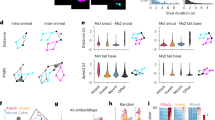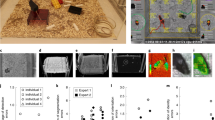Abstract
Recent innovations in sensing and Information and Communication Technology (ICT) have enabled researchers in animal behavior to collect an enormous amount of data. Consequently, the development of an automated system to substitute for some of the observations and analyses that are performed currently by expert researchers is becoming a crucial issue so that the vast amount of accumulated data can be processed efficiently. For this purpose, we introduce a process for the automated classification of the social interactive status of two mice in a square field on the basis of a Hidden Markov model (HMM). We developed two models: one for the classification of two states, namely, indifference and interaction, and the other for three states, namely, indifference, sniffing, and following. The HMM was trained with data from 50 pairs of mice as provided by expert human observers. We measured the performance of the HMM by determining its rate of concordance with human observation. We found that sniffing behavior was segmented well by the HMM; however, following behavior was not segmented well by the HMM in terms of percentage concordance. We also developed software called DuoMouse, an automated system for the classification of social interactive behavior of mice, that was based on the HMM. Finally, we compared two implementations of the HMM that were based on a histogram and a Gaussian mixture model.
Access this chapter
Tax calculation will be finalised at checkout
Purchases are for personal use only
Similar content being viewed by others
References
Takahashi A, Nishi A, Ishii A et al (2008) Systematic analysis of emotionality in consomic mouse strains established from C57BL/6J and wild-derived MSM/Ms. Genes Brain Behav 7:849–858
Takahashi A, Tomihara K, Shiroishi T et al (2010) Genetic mapping of social interaction behavior in B6/MSM consomic mouse strains. Behav Genet 40:366–376
Arakawa T, Takahashi A, Tanave A et al (2012) A Markov transition score for characterizing interactive behavior of two animals and its application to genetic background analysis of social behavior of mouse. Proc Measur Behav 2012:279–282
Arakawa T, Tanave A, Ikeuchi S et al (2014) A male-specific QTL for social interaction behavior in mice mapped with automated pattern detection by a hidden Markov model incorporated into newly developed freeware. J Neurosci Methods 234:127–134
Rabiner LR (1989) A tutorial on hidden Markov models and selected applications in speech recognition. Proc IEEE 77:257–286
Eddy SR (1996) Hidden Markov models. Curr Opin Struct Biol 6:361–365
Eddy SR (2004) What is a hidden Markov model? Nat Biotechnol 22:1315–1316
Kitagawa G (1987) Non-Gaussian state-space modeling of nonstationary time series. J Am Stat Assoc 82:1032–1063
Author information
Authors and Affiliations
Corresponding author
Editor information
Editors and Affiliations
Rights and permissions
Copyright information
© 2017 Springer Science+Business Media LLC
About this protocol
Cite this protocol
Arakawa, T., Tanave, A., Takahashi, A., Kakihara, S., Koide, T., Tsuchiya, T. (2017). Automated Estimation of Mouse Social Behaviors Based on a Hidden Markov Model. In: Westhead, D., Vijayabaskar, M. (eds) Hidden Markov Models. Methods in Molecular Biology, vol 1552. Humana Press, New York, NY. https://doi.org/10.1007/978-1-4939-6753-7_14
Download citation
DOI: https://doi.org/10.1007/978-1-4939-6753-7_14
Published:
Publisher Name: Humana Press, New York, NY
Print ISBN: 978-1-4939-6751-3
Online ISBN: 978-1-4939-6753-7
eBook Packages: Springer Protocols




